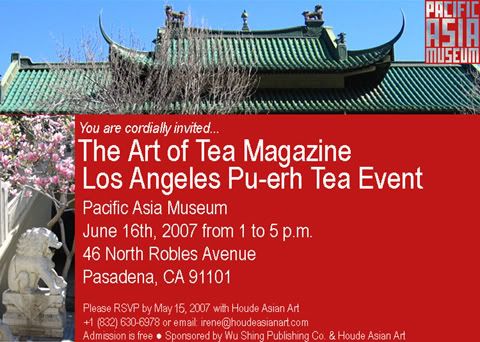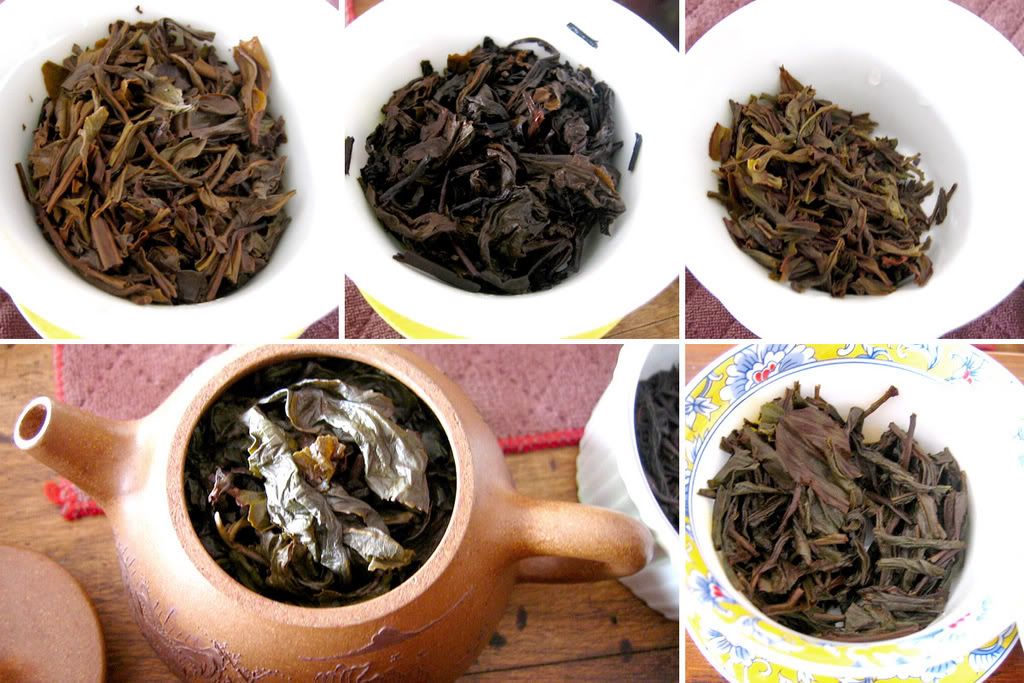Thursday, March 29, 2007
Silver Dragon, Silver Phoenix, Oriental Beauty
Sunday March 25th. I arrived late to be greeted by Danica, Jonathan, Louise and Will. They were already in mid-session of tasting a Wuyi rock oolong called the Thousand Sweet Miles. Feeling comfortable, I immediately slinked right in and joined the fun at the table. The tea was sweet smelling, floral and honey. It was also mellow and smooth with only a bit of roast. I liked it. This sample came from Best Tea House’s British Columbia (Canada) branch and costing C$112 per 100gr. Quite steep. We couldn’t figure out what this Thousand Sweet Miles is called in its original Chinese tea nomenclature (anyone?).
And then there is Stéphane Erler’s silver teapot -- Now Danica's. Danica unleashed the silver beauty from its original packaging only moments before I showed up. It was its own feature debut! One side of it is embossed in dragon. The other side’s embossing is of a phoenix. Rather surprisingly to me, it felt very solid, thick, substantial and balanced! From all the pictures that I’ve seen in Stephane’s blog, I (incorrectly) assumed that the teapot is thin and light. A lot of sterling silver (995) went into the making of this pot. When I brewed a tea with it, the pour was smooth and it did not drool or leak from its lid. It is an excellently made teapot overall. Well, for the precious material used and the high price one has to pay for it, it better be.
Danica unleashed the silver beauty from its original packaging only moments before I showed up. It was its own feature debut! One side of it is embossed in dragon. The other side’s embossing is of a phoenix. Rather surprisingly to me, it felt very solid, thick, substantial and balanced! From all the pictures that I’ve seen in Stephane’s blog, I (incorrectly) assumed that the teapot is thin and light. A lot of sterling silver (995) went into the making of this pot. When I brewed a tea with it, the pour was smooth and it did not drool or leak from its lid. It is an excellently made teapot overall. Well, for the precious material used and the high price one has to pay for it, it better be.
Tieguanyin Tea: Silver vs. Clay
Having never been used before, Danica rinsed its inside – which looked matted and resembled more of white oyster pearl than silver – with boiling water straight from her tetsubin. Then she asked Will to take over the helm. Will decided to brew a Tea Gallery’s qingxiang tieguanyin. Nosing the first brew (second after rinsing), Louise’s sensitive nose detected a certain metallic smell and taste. Others concurred. Jonathan said it could be psychosomatic. We asked each other whether the pot ought to be washed thoroughly first under the sink. We decided not to, unless somebody dropped on the floor writhing in pain. The second brew did not have as much of that metallic taste. Probably it’s the tea.
After 3 or 4 rounds, we decided to brew the same tea using a hongni clay Yixing pot. The result was noticeably different, although Louise again detected some metallic smell in the first brew. Must be the tea then. Coming out of the silver teapot, the tieguanyin had a hard and crisp edge to it. From the Yixing pot the tea felt more rounded and, well, not crisp. I remember Jonathan sharing this opinion and liking the tea from the Yixing better. So did I.
As an amateur photography hobbyist, an analogy that I can think of is that of a person being photographed with a direct, undiffused strobe light vs. with a bounced and diffused strobe light. The former is what the silver pot would produce in a manner of speaking. If this analogy is correct, then only model teas can withstand the unflattering effect of this silver being and come out beautifully. In my opinion, this tieguanyin test suggests strongly that a Yixing or a gaiwan is not replaceable by a silver unless one only brews exceptional tea every time. It is a teapot that you whip out to showcase your best teas and/or to impress and honor your guests with. It works well as a status symbol, too. You get instant credibility as a tea connoisseur brewing with it.
A Beautiful Oriental
After Will, Danica gave me the high honor of sitting on the brewer’s chair to handle a very special tea. I politely declined but she insisted, so I relented. A gift from Stéphane to Danica was 4gr of a rare Oriental Beauty oolong, which he himself was only allocated a mere 25gr. Allow me to summarize by saying I would kill for his 21gr. I kid you not it’s that good. I would rate it 5 stars. It’s so exotically perfumed with an aftertaste to die for. An hour after my last cup I could still taste it in my mouth. Stéphane said in his email to me:
“It was made by a farmer in Nantou: only 1.2 kg, if I remember well. It is the most precious tea from that farmer (a tea he did to push the limits of quality, not a tea made for sale). Extremely high quality and very expensive to make. A rather low oxidation for OB. The tea vendor I got it from said it was a white tea, but several tea friends/experts had a look at it and we all agreed it was an Oriental Beauty with low oxidation.” I was actually surprised by how greenish-white the resulting liquor was. I never had an Oriental Beauty with such a color before. The tea has a vivid spicy floral perfume and a lasting aftertaste. Looking at the leaves inside the silver pot, they were entirely made of dark green-colored buds (one flag, one spear).
I was actually surprised by how greenish-white the resulting liquor was. I never had an Oriental Beauty with such a color before. The tea has a vivid spicy floral perfume and a lasting aftertaste. Looking at the leaves inside the silver pot, they were entirely made of dark green-colored buds (one flag, one spear).
After only 3 cups of this memorable tea, I had to excuse myself and leave to pick my family up for a meeting at the Descanso Gardens with some relatives and friends. Any day I learn and experience something new is a good day. That Sunday was one of them. The only thing infinitely better than brewing with this exquisite shiny pot and tasting the special Oriental Beauty tea was the company I enjoyed them with.
My huge thanks go to Danica and Jonathan for hosting the meeting and for the special memory of that day. I feel very fortunate and privileged.
[Photo of wet leaves by Will]
Wednesday, March 28, 2007
Blind Tasting of 4 Water Brands
Last night I blind tasted 4 brands of commercially available water: CG, WFM, Evian, and Glacier vending machine (reverse osmosis with mineral add back).
Result of blind tasting: CG and WFM taste identical to each other (please note that both brands were bottled by C.G. Roxane). Where I am, the water comes from CGR’s Olancha Peak, CA facility. Both are clean tasting and quite neutral overall. Evian has a very clean and crisp aftertaste, but also rather thin and hollow. Glacier (reverse osmosis vending machine) has a rounded mouthfeel and a kind of sweet aftertaste.
Oh, and all water were poured into 4 Spiegelau white wine crystals to allow swirling before tasting (asked my wife to pour while I hid).
Why do I feel the $0.25/gallon vending machine water wins? It brews decent tea, really.
PS: Those thinking of becoming water connoisseurs should read Fine Waters: A Connoisseur's Guide to the World's Most Distinctive Bottled Waters by Michael Mascha (Quirk Books, October 2006).
Monday, March 26, 2007
Images of Spring Time
And children kissing (my daughter kisses her baby cousin)

Next post...a special tea tasting at Danica's.
Saturday, March 24, 2007
"Nyet!" to Czar Nikolas II Russian Tea
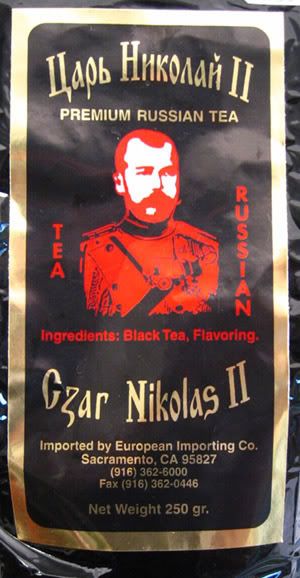 With all due respect to the dead Czar himself, I am afraid I don't have the stomach nor the will to ingest his tea. (to readers who want to know how I got this tea, please refer to my March 18 post, last paragraph).
With all due respect to the dead Czar himself, I am afraid I don't have the stomach nor the will to ingest his tea. (to readers who want to know how I got this tea, please refer to my March 18 post, last paragraph).Last week, I placed half of the tea package content into a metal can with a sheet of white paper placed on the bottom. When I was about to discard the tea this morning, Wa-Wa-Wee-Wa! (I just finished watching Borat on DVD). The white paper is pockmarked with green, oily blots all around!
What did they do to the tea? Did they soak it in some kind of aromatheraphy oil? Is it even safe to drink the stuff? I dare not try...it looks and smells harmful to me. Off everything went into the trash.
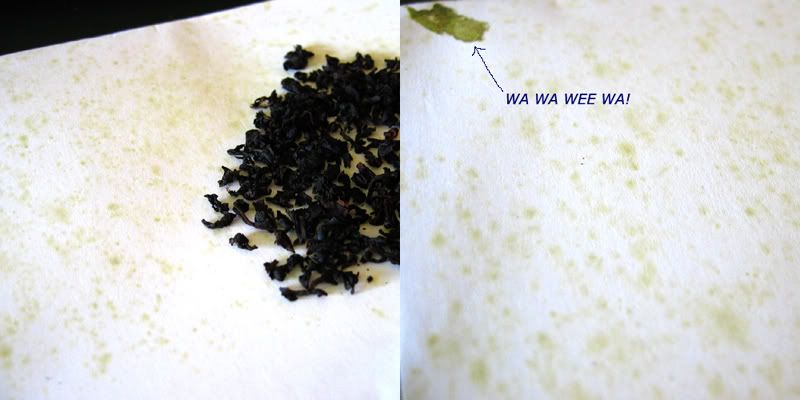 Satisfying my curiosity -- $4.99
Satisfying my curiosity -- $4.99Throwing my curiosity away -- free of charge
Keeping my health intact -- priceless
Thursday, March 22, 2007
Ongoing and Upcoming Online Tasting Events
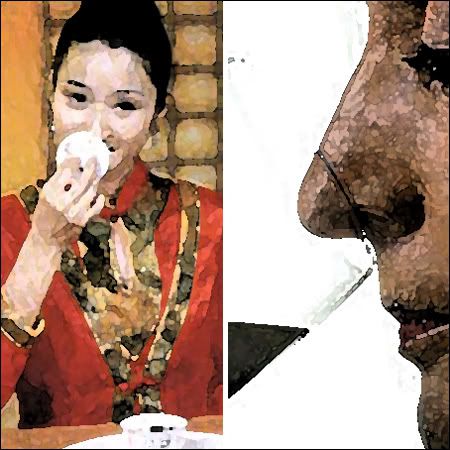 Ongoing Winexiles wine tasting: Tonight! 2003 or 2004 E. Guigal Crozes-Hermitage wine from the Rhone Valley, France. (as mentioned in my March 8 post). Post away your tasting notes in this thread.
Ongoing Winexiles wine tasting: Tonight! 2003 or 2004 E. Guigal Crozes-Hermitage wine from the Rhone Valley, France. (as mentioned in my March 8 post). Post away your tasting notes in this thread.Upcoming T Ching tea tasting: T Ching will be hosting the 2nd online tea tasting. The theme is going to be 2 rare Japanese sencha -- Tenbu and Tenbu Fuka. Those who participated or expressed interest in the previous Darjeeling oolong tasting will receive the sencha samples automatically, unless you inform Michelle that you would like to opt out. New interested participants will be sent the teas on a first come first serve basis due to limited supply. Exact tasting date is to be announced. CLICK HERE for more detail.
If you are unsure whether you submitted your name for the previous tasting, do email Michelle Rabin your contact information.
Wednesday, March 21, 2007
TN: Chen Guang -- He Tang Yiwu Pu'er
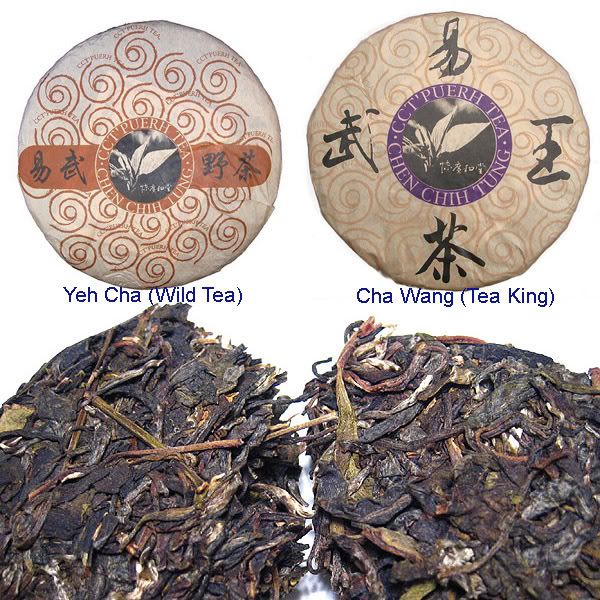 Mr. Chen Chih Tung is a renowned tea personality, a rock star in the Asian world of Pu'er. He is, after all, the author of the authoritative compendium on Pu'er titled "The Profound World of Chi-Tse", and he has collaborated with various big name pu'er producers. Some of the teas that bear his validation (through his personal supervision of the production process) are the Chang Tai South East Asian Puerh Trade Memorial Cake series and, more recently, his own Chen Guang-He Tang Yiwu series (autumn harvest).
Mr. Chen Chih Tung is a renowned tea personality, a rock star in the Asian world of Pu'er. He is, after all, the author of the authoritative compendium on Pu'er titled "The Profound World of Chi-Tse", and he has collaborated with various big name pu'er producers. Some of the teas that bear his validation (through his personal supervision of the production process) are the Chang Tai South East Asian Puerh Trade Memorial Cake series and, more recently, his own Chen Guang-He Tang Yiwu series (autumn harvest).When a tea bears his name or is associated with him, you have to think that the product is as good as it gets.
Several enthusiasts got together online and exchanged honest opinion on the two 2006 Chen Guang - He Tang teas that recently became available in the U.S. through Houde Fine Tea. Click here to read other participants' tasting notes posted on LJ Puerh Community (lots of pictures).
Tasting Notes
2006 Chen Guang-He Tang “Yeh Cha” ("Wild Tea")
Parameter: just boiled water, filled gaiwan 1/3 full of dry leaves, flash rinse, then 15s, 10s, 15s, 25s, 30s, 45s...
Seaweed, green vegies and salty plums from the wet leaves. The tea itself is rather thin and monotone. The chaqi is weak and the aftertaste is uninspiring. Nothing interesting about it in the mouth. Liquor is rather cloudy. Weak, dusty tannin for such a young tea. I have my doubts in this tea’s ability to age well. Boring overall. 1 star (not good, not bad)
2006 Chen Guang-He Tang “Cha Wang” ("Tea King")
Parameter: just boiled water, filled gaiwan 1/3 full of dry leaves, flash rinse, then 15s, 15s, 15s, 25s, 30s, 45s, 1m, 1.5m, 2m,...
Quite the opposite of the Yeh Cha. This tea is complex with overtones of yellow fruits, sweet plums and some smokiness. I particularly like the conservative amount of smoke in this tea that blends well with the overall fruity characteristics. Lively in the mouth with lots of infusions to offer (I had 8 before stopping, but the tea still could go for more). Good chaqi, full mouthfeel and with an aftertaste that persists. Abundant fine dusty tannin (this should be a good backbone for aging). The mellow complexity of the Yiwu shines through quite prettily in this tea. It should be interesting to find out how it ages, and it has a lot of potential given how it is today. 4+ stars (vg+)
The difference between the two teas, taste-wise, is quite significant, in my humble opinion. It is hard to differentiate their quality just by looking at the dry leaves alone -- both look almost identical. The Cha Wang does have more leaves that are covered with white fur than the Yeh Cha version. Both teas are nicely compressed (not too loose, not too tight).
[Photo: discs (top) by Houde Fine Tea; tea leaves (bottom) by Phyll Sheng]
Sunday, March 18, 2007
St. Pat's Weekend Notes
 Ah, spring is in the air! I’m sure you’ve noticed that tea vendors are offering the spring harvest already. Long Jing, Taiwanese oolongs, Mengding, etc. While I’m not a Japanese tea drinker, word on the street is that Shincha has already come out or about to. So much good tea…very tempting!
Ah, spring is in the air! I’m sure you’ve noticed that tea vendors are offering the spring harvest already. Long Jing, Taiwanese oolongs, Mengding, etc. While I’m not a Japanese tea drinker, word on the street is that Shincha has already come out or about to. So much good tea…very tempting!Unlike tea plantations, however, the grape vines are only budding right about now…there is still 5 to 6 months before harvest time. That doesn’t mean wineries aren’t buzzing. The good people of the grapey clan are busy re-racking or bottling the harvest of yesteryear(s), not to mention tending the vines.
I had a pretty nice weekend. Among other things, I dim-summed at the Empress Pavilion in Chinatown with the family (my younger sis joined). Loads of good dumplings! As usual, I brought my own tea…and this time instead of bringing some fisted oolong, I decided to take the Okayti Ivory Darjeeling oolong that I wrote about a few posts down. It was way much better than the restaurant’s tea to no one's surprise. I found out that this particular Darjeeling oolong is actually quite excellent when paired with dim sum dishes. Think of riesling or gewürztraminer with Chinese food, only this is tea. The fact that it is slightly more acidic (lively!), highly aromatic and it can take brewing abuse well, made the tea suitable in restaurants. When placed in a standard Chinese restaurant porcelain teapot and brewed over a long period of time, it didn’t get bitter and it remained pretty smooth.
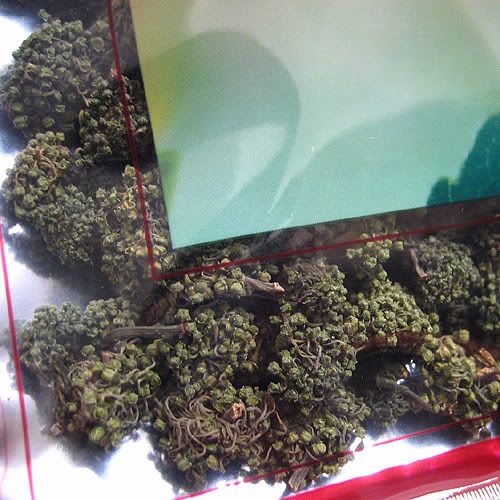 After dimsum, we stopped by Wing Hop Fung where I bought 2 teacups to replace the broken ones. I also got some dragon pearl jasmine tea for my mom-in-law. While browsing around, something caught my interest. Among the Soumei and Baimudan teas, there was this green herbs that is labelled as "Yunnan Thien Ji tea" (it's not tea tea, but rather a type of herb). They look like tiny brocolli florets and fresh green in color. Two customers were chit chatting with the saleslady about this very thien ji. They were speaking in a Chinese dialect that I couldn't understand (Teochew?) when I approaced the saleslady, who recognized me from my prior visits and invited me to try the "tea" out. It's bitter-sweet in an herbal kind of way...almost like ginseng. I can't really describe it. It's not bitter like kudingcha and it leaves a certain pleasant aftertaste. The saleslady and the 2 customers proceeded to tell me to only put about 7 "flowers" if I want to drink it straight. It can be mixed with other teas as well, they said ("Don't put too much, though," they added). So I grabbed 2 oz of this herb, which cost me about $3.50. I took the photo above at home...haven't opened the sealed bag yet. I will write about it when I try it again. Does anyone know what this is and how to treat it right?
After dimsum, we stopped by Wing Hop Fung where I bought 2 teacups to replace the broken ones. I also got some dragon pearl jasmine tea for my mom-in-law. While browsing around, something caught my interest. Among the Soumei and Baimudan teas, there was this green herbs that is labelled as "Yunnan Thien Ji tea" (it's not tea tea, but rather a type of herb). They look like tiny brocolli florets and fresh green in color. Two customers were chit chatting with the saleslady about this very thien ji. They were speaking in a Chinese dialect that I couldn't understand (Teochew?) when I approaced the saleslady, who recognized me from my prior visits and invited me to try the "tea" out. It's bitter-sweet in an herbal kind of way...almost like ginseng. I can't really describe it. It's not bitter like kudingcha and it leaves a certain pleasant aftertaste. The saleslady and the 2 customers proceeded to tell me to only put about 7 "flowers" if I want to drink it straight. It can be mixed with other teas as well, they said ("Don't put too much, though," they added). So I grabbed 2 oz of this herb, which cost me about $3.50. I took the photo above at home...haven't opened the sealed bag yet. I will write about it when I try it again. Does anyone know what this is and how to treat it right? On the way back we stopped by a Russian grocery store for some everyday staples (sosisky, kevir, kalamata olives, etc.) when I found this (see pic, click to enlarge). My curiosity cost me $4.99 for the 250gr bag. When I opened it at home, the loose smallish, black leaves reeked of menthol / eucalyptus / mint. Very strong! I kid you not when I say it smells like a mosquito or insect repellant that is made from a certain tree oil that you can apply on your skin. How does it taste? I am still summoning the courage to brew it. Somehow, I think it’s beter suited as a bathroom deodorizer or a closet moth repellant. It smells toxic to me.
On the way back we stopped by a Russian grocery store for some everyday staples (sosisky, kevir, kalamata olives, etc.) when I found this (see pic, click to enlarge). My curiosity cost me $4.99 for the 250gr bag. When I opened it at home, the loose smallish, black leaves reeked of menthol / eucalyptus / mint. Very strong! I kid you not when I say it smells like a mosquito or insect repellant that is made from a certain tree oil that you can apply on your skin. How does it taste? I am still summoning the courage to brew it. Somehow, I think it’s beter suited as a bathroom deodorizer or a closet moth repellant. It smells toxic to me. Hope you had a fun St. Pat's weekend!
Hope you had a fun St. Pat's weekend! Thursday, March 15, 2007
The Los Angeles Tea Party
The following is the account of the day by Danica and Will:
 It was a hot hazy day in Los Angeles as we made our way to one of the city's trendiest and coolest neighborhoods, Echo Park. Taking Sunset or a very crowded freeway through the colorful neighborhood of exotic crafts and trendy fashion, we made our way into the hills where we found Will's apartment tucked away in a cute mid-last-century apartment complex.
It was a hot hazy day in Los Angeles as we made our way to one of the city's trendiest and coolest neighborhoods, Echo Park. Taking Sunset or a very crowded freeway through the colorful neighborhood of exotic crafts and trendy fashion, we made our way into the hills where we found Will's apartment tucked away in a cute mid-last-century apartment complex.We were greeted by Will's fluffy calico cat, Scarlett, who made sure to keep us company while we drank tea, and entertained us by jumping on the roof of a shed next door to show her climbing prowess. Will and Louise served delicious dim sum, which as a raw food eater wasn't quite my cup of tea, but Jonathan had many mouthfuls and enjoyed himself. Luckily for me, the two plus liters of tea we were about to drink did not have a negative effect on my stomach.
There was an energy in the room that suggested something bigger than just a gathering of tea lovers. As Jonathan put it, "This feels like a Tea Happening."
The interesting thing that this Tea Happening dared to try is a big group tasting. I had heard in the past that tea is best drunk in small numbers: one for contemplation, two for friendship, three for conversation, and four for fun, but more becomes a distraction and even a dilution of the experience. At our first tasting, Will, Phyll and I were the devotees, but now Jonathan and Louise were fully on the tea bandwagon, plus Imen and Nick were to join us.
Being a lover of what I read in books (and the advice given to me by sage tea friends), I even suggested that we break up into two groups. The group was adamant that we drink together, so this was not just an ordinary tea tasting. were going to dare a simultanous tasting with six people. The results were surprising.
Four of us took turns brewing the tea: Will, Danica, Imen, and Nick. We learned from each other's brewing techniques. It was interesting how varied each person's techniques were: Will casually measured amounts into his gaiwan but used carefully heated water to produce tasty infusions; Imen blasted her leaves with boiling water, tasting the rinse water, then did short, incredibly flavorful infusions; Nick poured directly into his pot to get a strong vegetal high mountain flavor; and Danica was very careful in how she poured the water, brewing strong infusions of tea (frankly I've gone over to Imen's style as I really dig the layers of complexity that it evokes).
 espresso-like flavor. Will was a little bit competitive but up for a good time. Jonathan and Louise had distinct and strong opinions about the teas. It was a great group!
espresso-like flavor. Will was a little bit competitive but up for a good time. Jonathan and Louise had distinct and strong opinions about the teas. It was a great group!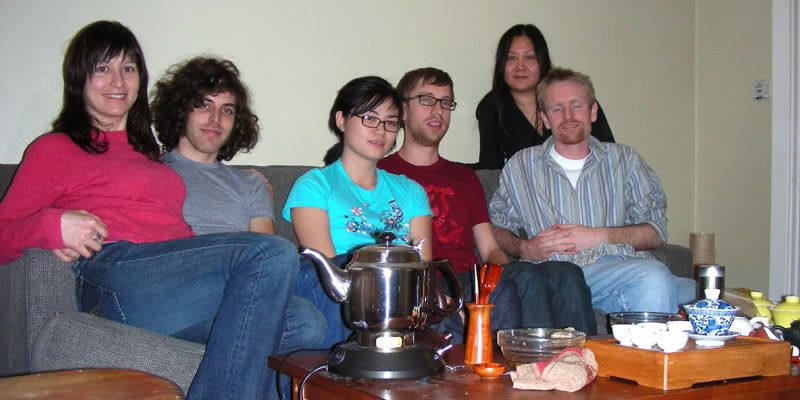
Left to right: Danica, Jonathan, Louise, Will, Imen and Nick
 The tasting moved along at a leisurely pace, lasting from around 2 PM to just after 7 PM. We had some snacks (mostly northern Chinese breakfast foods from Yi-Mei in Monterey Park - vegetarian Fan Tuan (chinese doughnuts with preserved cabbage, nuts and rice wrapped around them), mung bean pastries, and lu dou gao (mung bean tea-cakes), By the end of the evening, my hands were a little shaky from all the caffeine.
The tasting moved along at a leisurely pace, lasting from around 2 PM to just after 7 PM. We had some snacks (mostly northern Chinese breakfast foods from Yi-Mei in Monterey Park - vegetarian Fan Tuan (chinese doughnuts with preserved cabbage, nuts and rice wrapped around them), mung bean pastries, and lu dou gao (mung bean tea-cakes), By the end of the evening, my hands were a little shaky from all the caffeine.
We brewed mostly in large 6-7 oz gaiwans, as well as a few smaller teapots. We used my little ~ 1 oz cups, so surprisingly, even the small ~ 4 oz teapots seemed to make enough tea for everyone. We probably did at least 5-7 infusions for each tea, so maybe 50-80 oz of tea each.
1 oz cups, so surprisingly, even the small ~ 4 oz teapots seemed to make enough tea for everyone. We probably did at least 5-7 infusions for each tea, so maybe 50-80 oz of tea each.
TASTING NOTES
TEAS:
1) Roasted TGY (Tea Gallery) - Will
2) Bai Hao (ITC) - Will
3) Qi Dan Da Hong Pao (Golden Tea House) - Danica
4) Bai Ji Guang (Tea Gallery) - Will
5) Bai Sui Xiang (Golden Tea House) - Danica
6) Milan Dancong (Wing Hop Fung) - Imen
7) He Huan Shan High Mountain Oolong (2k-3k meters) (somewhere in Taiwan) - Nick
8) Rou Gui (Golden Tea House) - Danica
9) "88" dry stored Ching-Beeng #7542 (circa 1989) (Hou De) - Will
10) Mystery Menghai ~ 20 yr old sheng / shou mix (Nick's friend) - Nick, brewed by Imen
11) Song Zhong Dancong (Tea Gallery) - Will
12) '05 Song Zhong Dancong (from China via Imen) - Imen
Houde Fine Tea (Houston, TX): www.houdeasianart.com
Imperial Tea Court (SF): www.imperialtea.com
Tea Gallery (NYC): www.theteagallery.com
The Golden Tea House (Canada): www.goldenteahouse.com
Wing Hop Fung (LA): www.winghopfung.com
1) Roasted TGY
2) Bai Hao
Will: I like this tea (my first "Oriental Beauty", so not much basis for comparison)... though it reminds me of that "tea" taste (like a black / red tea taste) I remember from occasional sips of tea when I was young (teabag tea), only better and with a delicate sweet overtone. Imen said she would like it brewed a bit lighter and that it would be more of the sweet flavor then; maybe I'll try it with less leaf next time I make it. The wet leaves are beautiful - very small buds.
3) Qi Dan Da Hong Pao
Will: Not super high fire, but not that really aggressive "young" taste either. It had a beautiful honey taste that wasn't like the taste people call honey in other teas (TGY / Dancong etc.) - it was like an actual sweet honey taste or something, and if I remember correctly, the smell was very nice too. Pretty smooth. Not at all what I think of when I think of Da Hong Pao. I liked it, and I'd like to try this one again sometime.
4) Bai Ji Guan (White Rooster)
Danica: The dry leaves smelled like clean water and some vanilla and cream. The brew had strong notes of vanilla and orchid in the first few brews, becoming creamier later. Some of us were reminded of taiwanese oolongs by its flavor.
Will: When I ordered stuff from Tea Gallery, I had them send me a couple samples, and I let them include something they thought was particularly good. It seemed serendipitous that they sent a low fired Wu Yi tea when we were looking for something like that to drink at our tasting, and that it arrived the day before. My memory is kind of blank in this part of the tasting. This was my first time brewing this tea. Maybe I'll brew some more and come up with notes. I think it was pretty good and that people liked it.
5) Bai Sui Xiang (100 Years Fragrant)
Photo: Left, Bai Ji Guan; Right, Bai Sui Xiang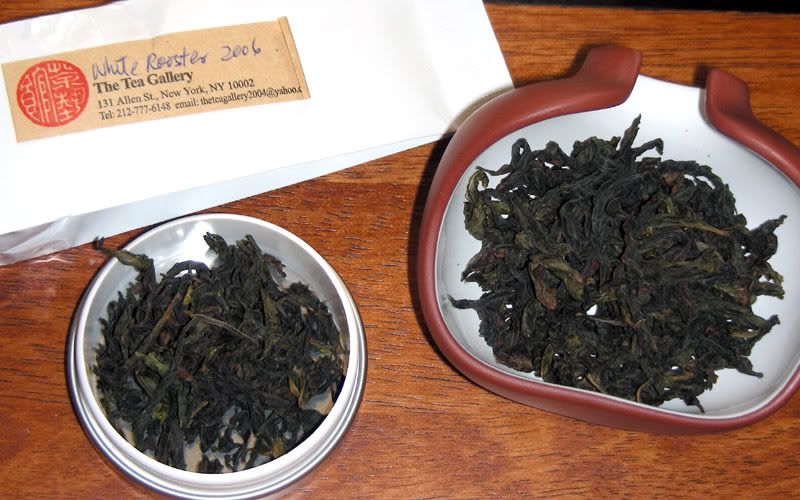
Danica: Louise or Imen said the flavor reminded them of vegetable soup. It has a very grassy, vegetal flavor with notes of hay. I later brewed it much lighter, per Imen's recommendation, and got the same grassiness but with more floral overtones.
Will: At first, we thought this was another Bai Ji Guang we had some interesting discussions about the correct Chinese name)... and the dry leaves were very similar in smell / appearance. This one was very grassy and kind of unpleasant at first. However, the later infusions (after the leaves opened up a bit) were better, brewed a littler stronger. Still, not really one of my favorites.
6) Milan Dancong
Danica: A very strong-roasted tea. This one had tremendous honey fruit floral flavor that lasted for many brews. It wasn't complex like the Song Zhong dancong but it was an excellent tea.
Will: I'm suffering from dancong overload what with this week and last week... this one was pretty nice - though I liked the ones we tried later a little more. Maybe a little less in your face fruity than some of the other ones, more of what Imen described as a "honey" flavor.
7) High Mountain
Danica: A vegetal, green, masculine high mountain tea. Nick brewed it strong. It wasn't as complex as some high mountain teas I've had but it opened up in the fourth steep and gave some floral notes.
Will: I don't really like this style of tea. I've had some really nice quality teas of this variety (including this one), and I just really don't care for them, for the most part. I liked the later, longer, stronger steeps better, but still not really my cup of tea (hah). Seemed to work pretty well in a ~ 4oz zhuni pear pot - and surprisingly, there was enough for all of us still.
8) Premium Rou Gui
Danica: This is an unusual tea that drew my attention for its smoky, sweet, caramelly flavor. It's a well composed, if unusual, interpretation of a traditional Wu Yi tea.
Will: I didn't quite know what to make of this tea. I didn't dislike it, but I don't know how to describe the taste in words - the smoky taste is different from the other smoky teas I've had. It reminded me of Spanish paprika (which has a smoked flavor) - not the paprika taste itself, but the smoky overtones. Smoky without being burned or charred. I didn't really taste the sweet / caramel taste that Imen and Danica tasted - maybe just a touch of it in the aftertaste. I think I'd have to try it another time or two, and maybe brew it myself, to decide how I feel about it.
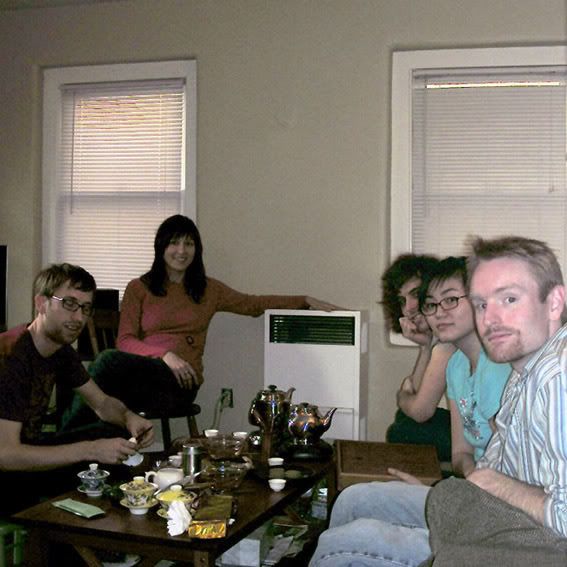 9) 88 Ching Beeng Pu'er
9) 88 Ching Beeng Pu'er
Will: I was sad that Phyll wasn't here to try this one, since he didn't like the one he tried. I tried this sample from Guang twice, and while I don't have a lot of experience with aged pu'erh, I like the taste. It's hard to describe, but mellow. I should note that by this point, my hands were starting to shake a little when moving the gaiwan lid. We went a bunch of rounds with this one, and could have probably gone on for quite a while.
Danica: This tea had an 'off' rinse steep, which Imen and the rest of us rejected on the basis of an unpleasant earthy flavor. The subsequent steeps were rich, flavorful, woody, earthy, with hints of fruit moving to sweet in later infusions. I think we went 8 or 9 with this one, primarily because I kept insisting we keep going. It was a great tea.
Phyll: Click here for my tasting note of this tea
10) Menghai mixed pu-erh
Danica: This tea was very mellow and easy to drink, with signs of good aging. You could taste the cooked, but the tea was powerful and Imen felt it could keep going for at least 20 infusions. In truth, cooked puerh is not usually my cup of tea, but this was quite easy to drink.
Will: Well I'm kind of proud of myself for suggesting that maybe it was a sheng / shou mix, since I guess that's what it turned out to be. We didn't think it was quite an aged sheng pu'erh, but it wasn't super heavily "cooked" either. Without knowing much about the tea or its origins (maybe a good thing), and without a ton of experience with pu'erh, I liked it. Smooth, earthy. The first brews had maybe a bit of a watery taste or feel, but towards the end it started getting nice and dark. I think we did at least 6-7 rounds. We could have brewed this one for a bunch more rounds also.
11) Song Zhong Dancong (Tea Gallery's)
Will: We probably could have stopped before here, but I thought it might be nice to end up back where we started - on a "sweet" note. After tasting the BTH Song Zhong Dancong, I thought their former students at Tea Gallery might have something similar with theirs. However this one (so far) to me doesn't seem anywhere near as complex. It's closer to the Milan Dancong from Jing that I brewed last time. Lots of lychee or maybe peach notes. The dry leaves look more highly roasted, but it's still pretty light and fruity. It's very nice and all that, and does get more complex after the leaves open more (and of course I may still learn to brew it better), but to me, it's not quite as good. Anyway, it's good, and cheaper than the BTH stuff (though more expensive than the Jing Milan Dancong) - just didn't completely blow me away. Probably if I hadn't had so much Dancong in the past few weeks, I'd like it more.
Danica: Very up-front fruity characteristics that developed more complexity with later brews. As Phyll noted in our other tasting, sometimes the Song Zhong Dancong takes a while to open up and get going. This one did around the fourth brew and was quite nice, although not as exceptional in aftertaste as the tea Phyll brought last week.
12) Song Zhong Dancong (From China)
Danica: for a tea from 2004 stored double bagged in a freezer we got tremendous flavor. Fruity and what could be called 'haunting' in the aftertaste, it really was 'wow' in the later (7th or 8th?) steeps, with an excellent kick. However it gave up its flavor soon after, which Imen attributed to the fact that we weren't using enough leaves.
Will: This was a nice one to end up on. Similar to the previous one, maybe a bit smoother and nicer. Someone said the leaves smelled like strawberries after they went into the hot gaiwan, and I kind of agree... maybe a little hint of this in the rinse and first steep or two as well. I have a hard time describing the mix of tastes in the later brews.
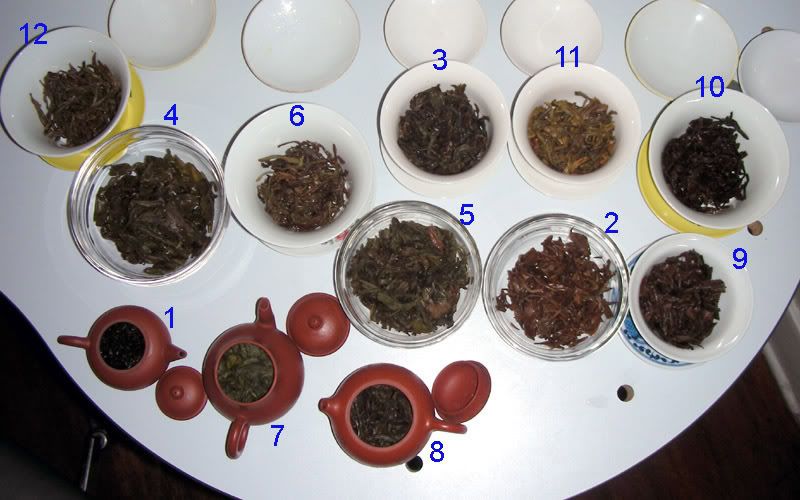
Wednesday, March 14, 2007
Less For Same
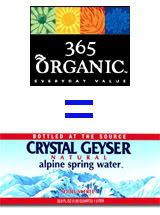
Well, not quite...
You're Fake, Aren't You?

Read: “Sniffing Out Fraud in the Bottle” by Eric Asimov for the New York Times
Tea Vodka
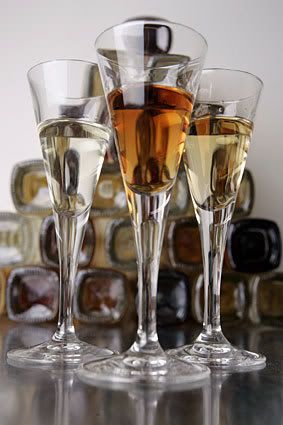
“The tea flavor, based on a mixture of black, green and oolong teas, is surprisingly rich, with a nose more like some sweet spice than like tea. This was Melkon's attempt to commemorate their honeymoon in France, where they'd made a memorable visit to an old tea house.”Guess what I’ll be bringing to a regular gathering with my Russian buddies? I doubt they will sip the vodka, though…that’s just too new school.
(Photo: Francine Orr / LAT)
More Darjeeling Oolong's
With these 2, I now have (only) tasted 5 different Darjeeling oolongs (3 with T Ching). Each one was quite different from another, which I found to be quite fascinating considering that they sprang from the same region. Still, there are common denominators among them. These are my impression and what I found to be the common characteristics among the 5 Darjeeling oolongs I tasted.
The 2 oolongs below were purchased from Wild Orchid Teas. The vintage year is not mentioned by the vendor. My guess is they are 2006 teas, though I can’t be sure which season they were harvested in.
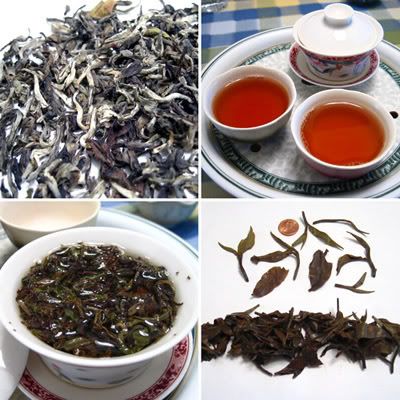 Excellent looking dry leaves. Twisted lengthwise and mostly whole. Evenly and generously downed with white fur. Nose is complex but more subdued and subtler than the other 4 Darjeeling oolongs…of mango, muscatel, peach…a mix of tropical fruits (common Darjeeling nose). The tea also tastes subtle and quite fragrant. Light to medium body. Short aftertaste. Quite charming and especially nice when in the mood for a subtler tea. 3.5 stars (g - vg)
Excellent looking dry leaves. Twisted lengthwise and mostly whole. Evenly and generously downed with white fur. Nose is complex but more subdued and subtler than the other 4 Darjeeling oolongs…of mango, muscatel, peach…a mix of tropical fruits (common Darjeeling nose). The tea also tastes subtle and quite fragrant. Light to medium body. Short aftertaste. Quite charming and especially nice when in the mood for a subtler tea. 3.5 stars (g - vg) Hillton Ebony Oolong, Darjeeling, India
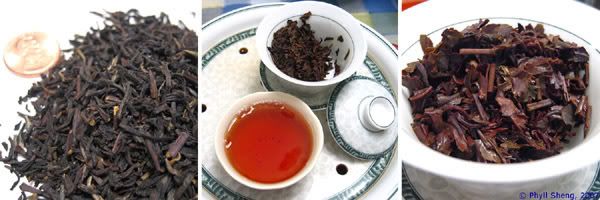 I have depleted my entire 100gr of this tea. I brewed it in many ways: in a small gaiwan (gongfu), in a large pot, straight in the cup, iced, not iced, etc. It is a good and pleasant tea for everyday, everyway. This is one tea that I consider having as a staple for fuss-free enjoyments.
I have depleted my entire 100gr of this tea. I brewed it in many ways: in a small gaiwan (gongfu), in a large pot, straight in the cup, iced, not iced, etc. It is a good and pleasant tea for everyday, everyway. This is one tea that I consider having as a staple for fuss-free enjoyments.Closer to being a black tea (“red tea” in the Chinese tea category), it is highly oxidized. The nose resembles a fully oxidized 2nd flush tea, though slightly softer and fruitier. The liquor brews quite red when done in a gaiwan. (Otherwise, it is medium amber/brown in a 5-cups Bodum teapot with ~4 teaspoons of leaves). Tastes more robust than the other 4 teas. Quite smooth and not tannic. Refreshing and good tasting with ice! A very versatile tea that can withstand abusive brewing methods, yet delivers a pleasant enough taste. Does not break the bank ($12/100gr). 3 stars (g)
Tuesday, March 13, 2007
Thank You V.L.!

Saturday, March 10, 2007
Best Viewed With Internet Explorer

Thursday, March 8, 2007
Monthly Wine Tasting @ Winexiles

Wednesday, March 7, 2007
Lu Yu & Mary Ewing-Mulligan, M.W. Advised...
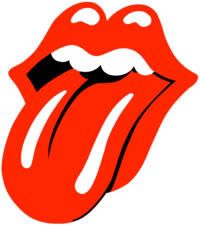 ...you to trust your own mouth.
...you to trust your own mouth.“The really superior taster will judge tea in all its characteristics and comment upon both the good and the bad. For every individual criticism there is a reason. It’s goodness is a decision for the mouth to make.”
~ Lu Yu, Tea Sage (733 - 804 AD); As translated by Francis Ross Carpenter
"It is your mouth after all. No one can tell you what you like. No critics, no wine experts. Drinking wine is a very personal experience."
~ Mary Ewing-Mulligan, M.W. (Master of Wine); Read article
Tuesday, March 6, 2007
In Memoriam: Ernest Gallo (1909 - 2007)
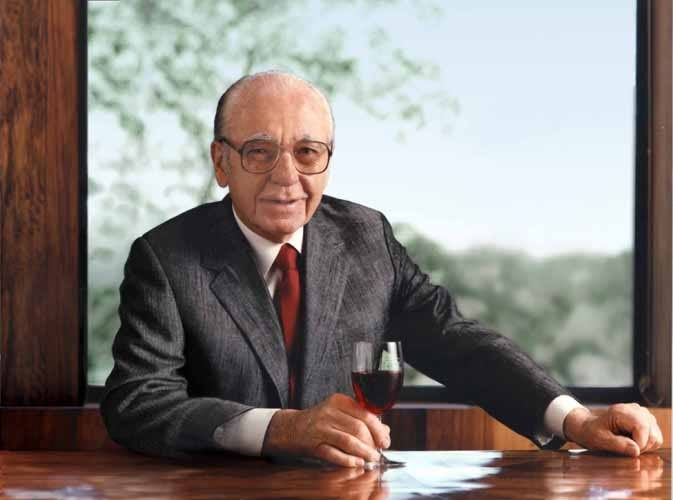 Raise our glasses to a visionary, a pioneer, and an entrepreneur! A very big guy in the American and global wine industry. Alla Salute!
Raise our glasses to a visionary, a pioneer, and an entrepreneur! A very big guy in the American and global wine industry. Alla Salute!Photo and article: www.gallo.com/ErnestGallo
Monday, March 5, 2007
A Relaxing, Spendthrift Weekend

On the way home from the party, I stopped by a big box wine store in West L.A. (Winehouse) to pick up the 2 cases of 2003 Bordeaux clarets that I purchased as futures about 2-3 years ago. They have been laying in Winehouse's cellar under my name all these while since they were released.
Inside the store, seeing all those bottles of wine lined up like rows of vine was extremely tempting to me. But first, the liquor aisle. I have run out of a good sipper at home.
Ever since I read a recent article – I forgot in which publication – about the growing trend of maturing Scotch whisky in barrels that were previously used to age different types of wine in (e.g. Sauternes, Sherry, Port, Madeira, Rum, Burgundy, etc.), I have wanted to try a good one that was aged in a sherry barrel. If I am not mistaken, Scotch whisky is traditionally matured in ex-barrels of Bourbon whiskey to give a certain oomph and finish. I love a good Scotch, but my knowledge of it is rather rusty.
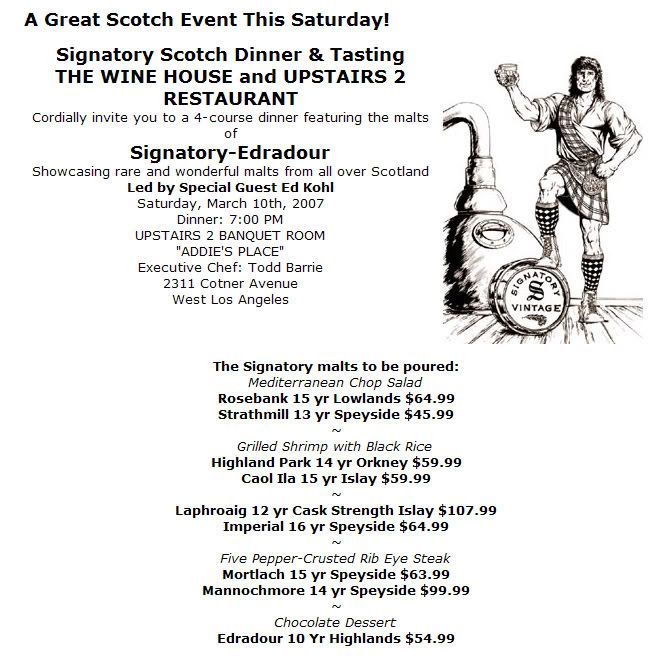 While browsing around in the whisky aisle, a guy named Tim, a Market Manager of a liquor distribution company called Total Beverage Solution, chatted me up. He was visiting the store that day to push his company's product line and promote an upcoming tasting event at the Winehouse (click inset on the right). Upon his inquiry, I said that I was interested in trying a sherry barrel-matured Scotch. He was more than happy to point to a bottle that his company represents: 1996 Signatory Edradour Unchillfiltered Highland 10 years Scotch. He also said that ex-sherry casks cost extensively more at $3,000 per barrel as compared with an ex-bourbon barrel, which costs only $150 per. Is that true? I’m not sure.
While browsing around in the whisky aisle, a guy named Tim, a Market Manager of a liquor distribution company called Total Beverage Solution, chatted me up. He was visiting the store that day to push his company's product line and promote an upcoming tasting event at the Winehouse (click inset on the right). Upon his inquiry, I said that I was interested in trying a sherry barrel-matured Scotch. He was more than happy to point to a bottle that his company represents: 1996 Signatory Edradour Unchillfiltered Highland 10 years Scotch. He also said that ex-sherry casks cost extensively more at $3,000 per barrel as compared with an ex-bourbon barrel, which costs only $150 per. Is that true? I’m not sure.From Tim’s description of the producer, Edradour is the smallest distillery in Scotland. Just by the salesman’s words alone, this bottling sounds more artisan to me than the widely available Glenmorangie and Macallan. I decided to give it a try. It set me back $66.
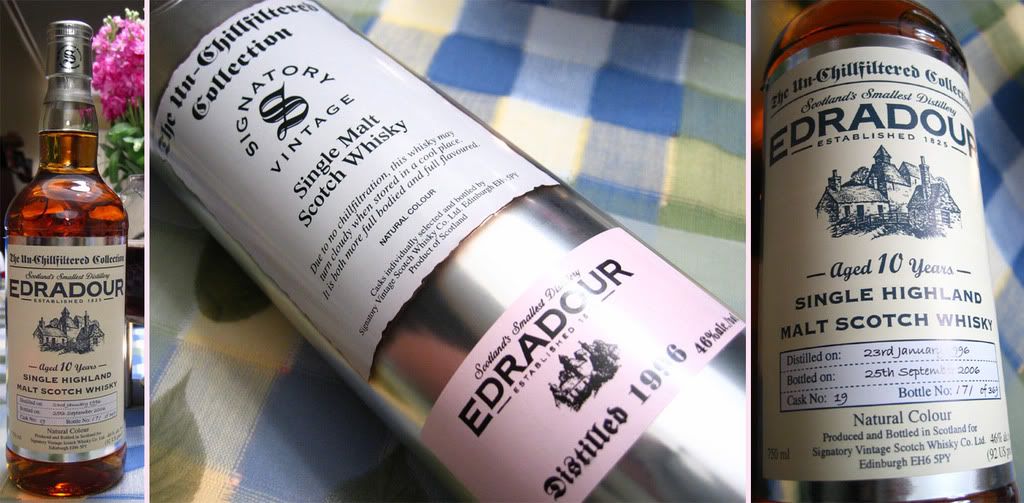 TN: 1996 Signatory Edradour Unchillfiltered, 10 years (46%)
TN: 1996 Signatory Edradour Unchillfiltered, 10 years (46%)Medium amber color. The nose is deeply sweet, like overripe yellow fruits, with some iodine and nuttiness. Spicy and woody. It's very silky...goes down smoothly like oil. Medium bodied. Finishes a touch acidic, fruity and caramel. This is an aperitif/digestif style. Enjoyed in a Riedel Vinum Cognac Hennessy tulip crystal with a spritz of mineral water added to 2oz of liquor.
On my way to the cashier, I tried to close my eyes as best I could to control the potential damage to my bank account. It didn’t work. At the check out I ended up with the following:
And the Bordeaux futures I picked up:
There goes my tea and wine allowance for many months…
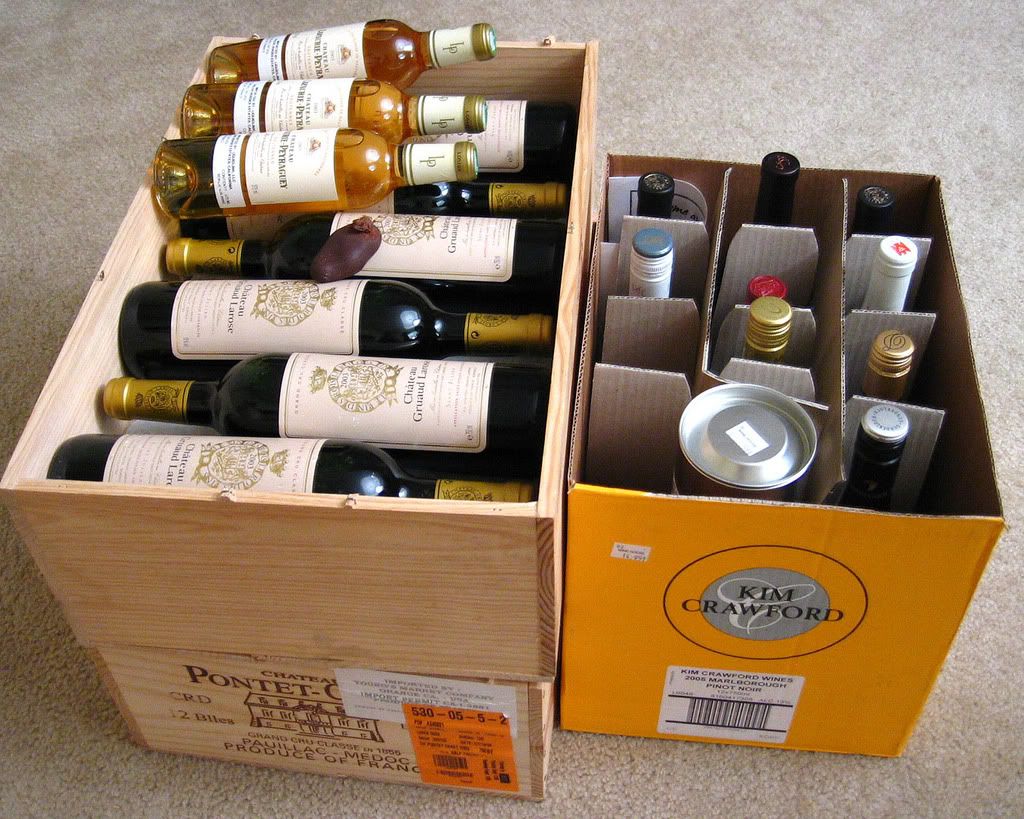 What have you been buying to satiate your tea and/or wine obsession?
What have you been buying to satiate your tea and/or wine obsession?
Friday, March 2, 2007
A Meeting of Tea Minds
 As I turned left onto Beachwood Drive, I glared at the H-O-L-L-Y-W-O-O-D sign boldly emblazoned up on Mt. Lee dead ahead of me. A local landmark that I usually take for granted, that day it was being shoved in my face and it was quite a sight! It reminded that no matter where I came from, I am now a subject of this little kingdom…this Tinseltown. And our king-elect is Arnold Schwarzenegger.
As I turned left onto Beachwood Drive, I glared at the H-O-L-L-Y-W-O-O-D sign boldly emblazoned up on Mt. Lee dead ahead of me. A local landmark that I usually take for granted, that day it was being shoved in my face and it was quite a sight! It reminded that no matter where I came from, I am now a subject of this little kingdom…this Tinseltown. And our king-elect is Arnold Schwarzenegger.
But I am not about to bore you with such stories…I’d rather talk about our tea gathering.
Sunday last, I was invited by Danica (Dah-nee-tsa), a film producer and a serious teahead, to her charming home for some tea. Also joining us were Jonathan, Will, Louise, and Danica’s black pug. The dog, judging by its color, is probably more of a coffee drinker. Did I just color-profiled Danica’s puppy? Somebody sue me!
The camaraderie developed almost instantly. It’s amazing to think how ol’ Ms. Camellia sinensis can bring different people together. I always say that friendship is the healthiest thing that comes out of tea – good friends are probably going to make you live longer than that EGCG-XYZ anyway.
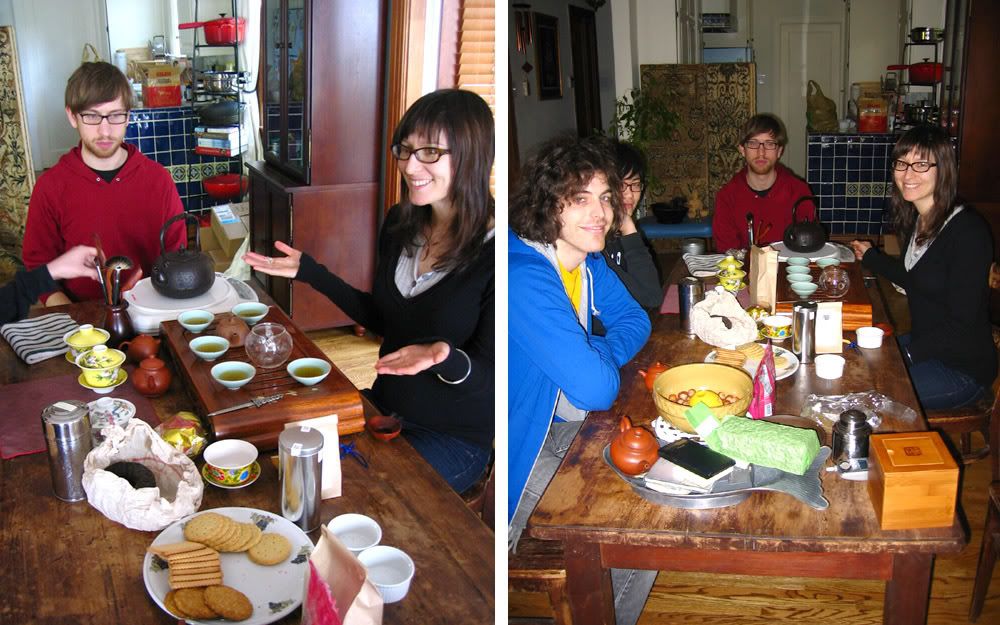
Right Photo (clockwise from left): Jonathan, Louise, Will, and Danica in charge of tea.
5 people, 1 dog, 4 solid hours, 6 teas, ~42 infusions, ~210 cups, no sweat!
1980’s Zhong-Cha (Menghai) #7532 Xiao Huang Yin Sheng Pu’er
Source: Houde Fine Tea
Danica: Very strong tea, with great cha qi lasting many steeps. Forceful woody quality that is balanced by earth and forest, with some astringency. Surprisingly young feeling, although the leaves look aged and the liquor shows signs of age. Becomes floral at the 9th steep; would have continued but I ran out of desire.
Will: I liked it - maybe a little on the young / bitter side for my taste still. I'm a little hesitant to talk about teas having strong qi, but this one did seem to have a kick beyond just caffeine.
Phyll: I remember this tea as tasting quite young and green still for an 80’s sheng. A lot of cha-qi and caffeine. The leaves are still quite young looking too, for a 20+ years old tea. I could feel myself feeling wired and tingly on my back after 4 cups or so. A lot of activity and taste there. This tea tastes like it’s been stored dry and clean. 4 stars (vg).
1985 Chan’s Tea House Sheng Pu’er Loose Leaves (stored for 20 years in Hongkong)
Source: Guangzhou
Phyll: Much older looking and tasting than the Xiao Huang Yin. Then again, I can say that this tea went through some mild wet storage period. The tea itself is earthy, woody, mellow and smooth. Not overly complex, yet there is something to be said about its subtleties. Calming and cooling, my body felt much better after this tea – it was like the XHY mentioned above created a fire and this loose sheng doused the fire. It is such a contrast to the 1980’s XHY. I rated it 3 stars before, and I still think it’s a 3 star.
Danica: Smooth liquor, comforting, with an earthy, mushroom note; possible wet storage or cooked (we didn't check the leaves!). Simple tea, easy to drink. Great for every day.
Will: This one was nice and mellow, in contrast to the other aged pu-erh. I liked it a lot. There was a weird flavor I couldn't quite put my finger on and certainly can't describe.
Highly Roasted “Monkey Picked” Tieguanyin
Source: Jing Tea of U.K.
Phyll: This tea has a wonderful aroma of nuts, caramel, honey, and various fruits. A complex tea overall, but the roast is (still) much too strong. Perhaps this was roasted fairly recently and it needs some resting time (months) to calm the fire. The charcoal aroma is too apparent. Otherwise, it is a wonderful tea. I loved it, despite. 3.5 stars (g – vg) due to too much charcoal. Otherwise it's 4 stars.
Danica: Very dark roasted appearance. The tea is strong and complex, dominated for the first 4 steeps by the roast. Leaves a wonderful caramel/ vanilla/ orchid/ complex scent in the cup that is quite revelatory. The caramel flavor begins to open up in later brews (I think it was #4); this could be in concert with the leaves opening in a very full teapot. Perhaps a longer brew time would also have given more flavor up front. Personally I found there to be a metallic note to the roast that reminded me of fuel, which may be a result of the charcoal. It made it less smooth and palatable for me. This note makes an otherwise 8.5 tea a 7.5 for me. Drinkable, interesting, but not perfect.
Will: This reminded me a lot of Stéphane's roasted high grade TGY (to be fair, that's the only other high-fire TGY I've tried). Slight differences, but the basic flavor is the same. I'm not sure which one I like better yet - maybe we should try a side-by-side. They both have a pretty strong taste of... I guess I'd call it caramel. The smell was very nice; Louise thought it had a bit of a sandalwood aroma. It looked a lot darker than the one in the picture I see on their site
Clockwise from top left: 1980's Zhong Cha Xiao Huang Yin Pu'er, 1985 Sheng Pu'er, 2006 Milan Dancong, Song Zhong Dancong, Long-an Taiwanese oolong (pot). Not pictured: Monkey Picked TGY.
2005 Long-an Wood Roasted (Heavy Fire) Formosa Oolong
Source: Houde Fine Tea
Danica: Round and fruity scent of dry leaves, more roasted smell from dry leaf. This one brews up strong; it has a consistent, fruity flavor with a nice hint of roast. The roast is different from the monkey pick, it is less prominent and less complex, but the tea is clean and pleasant-tasting. Good durability--I got at least 7. After brewing the leaves showed some oxidization but were primarily a shiny dark green color, with some stems. I had it again and brewed it a little lighter; I think Will would have enjoyed it more.
Will: It's described on Houde's site as "heavy fire" (maybe for Taiwan), but I'd describe it more as a medium or low-medium roast based on the appearance of the wet leaf and the taste of the tea. As brewed, it was a little on the bitter side for my taste (though everyone else seemed to like it -- I'm just weak sauce). Memory is failing me in terms of other specifics right now.
Phyll: This tea is rather simple tasting with a pleasant woody – fruity aroma. Though regarded as “heavy fire” by the vendor, it is much less roasted tasting than the abovementioned Monkey Picked TGY. A nice change of pace after the TGY…the difference between a dark roasted oolong (with charcoal?) and a traditional Taiwanese wood-fired oolong is very clear when tasted one after another. 3 stars (g)
Spring 2006 Milan Xiang Dancong Oolong
Source: Jing Tea Shop of Guangzhou
Will: I like this tea... I feel like it's almost *too* accessible (like maybe I'd get sick of it if I drank it all the time) - the lychee taste is right there to the point where it's very fruity. I like to brew it withnot too much leaf so the bitter notes don't take over. It's very lightly oxidized, and the taste is very light. The wet leaves also have a strong lychee smell.
Danica: Really lovely fruity dancong tea, Will described it as a lychee or maybe passion fruit flavor. Brewed well with fewer leaves, there was hardly a hint of bitterness.
Phyll: This is simply lovely! It is highly perfumed with all sorts of yellow fruits and flowers, noticeably peach, apricot, and floral (orchids, as the name implies). The aromas are very upfront and expressive from the very first brew. If it were an opera singer, I would say it’s a mezzo-soprano. Simply charming. Will used less leaves than I usually would brew my Dancong, and it came out very nice. 4 stars (vg).
Song Zhong Dancong (Highly Roasted)
Source: Best Tea House of Hong Kong
Phyll: The 2 previous times when I brewed this tea at home, I ended up with too strong a tea. So after witnessing that Will successfully brewed the Milan Dancong with less leaves, I decided to follow suit (about 1/4 full in a 100ml gaiwan). I think for this tea, it needed a little more leaves than the Milan Dancong, but less than what I used at home (1/2 of a gaiwan). It’s a learning curve. Dancong is rather hard to get right.
A late bloomer. The first 3 or 4 cups were light and rather sleepy. Then it gradually opened up on the 5th brew, giving nice complexities. The perfume that comes off of the tea gave a warmer feeling than the Milan Dancong. Peachy, honey, and floral. Very good aftertaste. 4 stars (vg)
Danica: This was an interesting tea with a wonderful and special aftertaste. It was complex and floral with a fruity main note. I can imagine if it was brewed stronger it would be extraordinary.
Will: This was very nice. Would have been nice to try it without knowing exactly what it was, since this tea's reputation precedes it. That said, I thought it was very nice. Similar notes to the Milan Dancong from Jing (lychee, peach), but a little less up front (I think Phyll made that point), more complex, and with a great lasting finish. You hear people talk about teas with a good finish / aftertaste, but this one really had a lot going on there. I'm glad we didn't skip this one, especially to taste right after the Jing one. Despite being fairly high-fired, the tea didn't have a strong oasted taste.
We are planning to meet again in a few weeks time, and hopefully Imen and Nick can join us.
